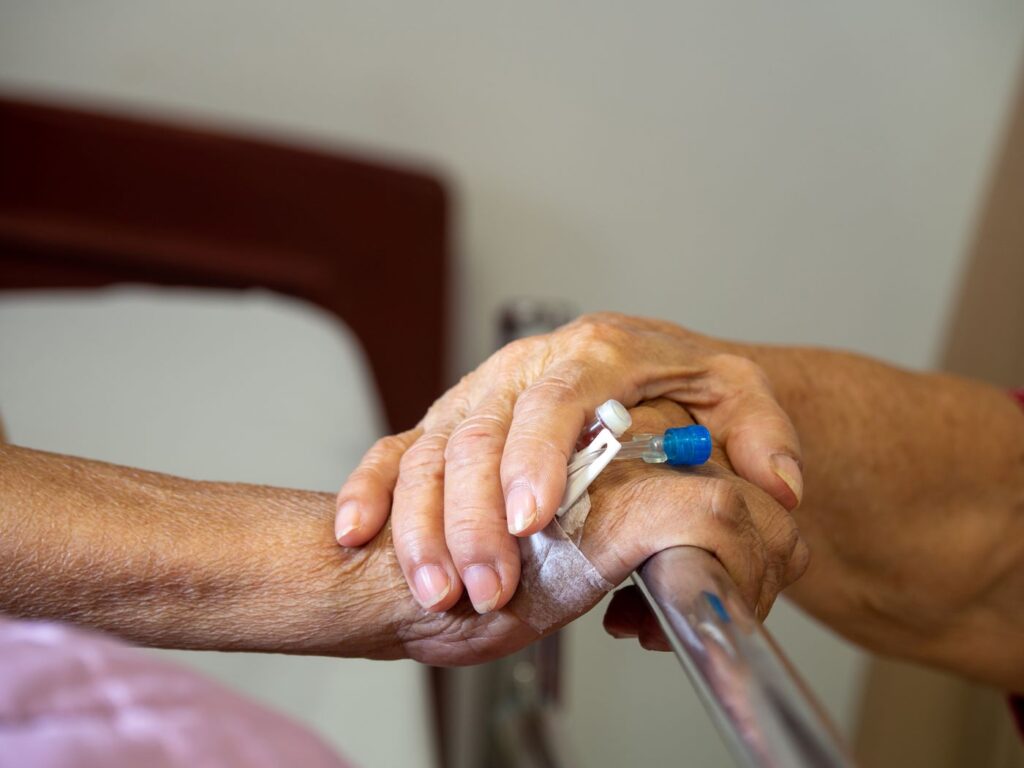Editors’ Note: This essay is a shortened, adapted version of a paper published in Theoretical Medicine and Bioethics on August 20. 2024. Portions of this essay were taken directly from the article, with permission from the publisher. The authors would like to acknowledge the contributions of their colleagues Anthony Tanous, and Tracy Balboni, who are co-authors on the paper.
While dying may be a time when agency and quality of life are limited, the end of life also presents unique possibilities for the realization of human goods. Some dying patients discover meaning by reflecting on the events of their lives and come to a deeper appreciation of their own life legacy. Terminal illness also presents opportunities for a deepening of close social relationships and the fulfillment of relationship commitments. Paradoxically, the end of life can be a catalyst for gratitude and self-transcendence. It is worth asking, then: can we flourish even as we approach death? And how can we help our loved ones flourish in their final days?
Human Flourishing and End-of-Life Care
Humans have long grappled with the question of what it means to flourish. According to Aristotle, flourishing is best understood as the action of a living thing in accord with its proper function. The English word flourishing has as its point of reference the vigorous development of a living thing over time. In the case of human beings, Aristotle takes this vigorous development to be constituted by rational activity in accord with virtue, given that a human being can be defined as a rational animal.
Start your day with Public Discourse
Sign up and get our daily essays sent straight to your inbox.One challenge to the notion of flourishing at the end of life is that the human body is, by definition, past its developmental prime and in a phase of active and sometimes rapid decline. One could question, then, whether flourishing is an appropriate concept to discuss in the context of end-of-life care. Today, people most commonly die from longer and more protracted forms of illness like heart disease, cancer, or neurodegenerative disease. These conditions can involve considerable pain and suffering and loss of function that preclude participation in social life and/or meaningful personal activities. Sometimes these conditions will be accompanied by dementia symptoms, which compound a sense of lost dignity among the sick and their loved ones.
The development of the field of palliative care and advances in pain science in recent decades have meant we can provide more humane care for the dying. Clinicians and researchers have also developed creative approaches to restoring a sense of meaning and hope to the lives of people suffering from terminal illnesses. For example, through dignity therapy in palliative care, healthcare professionals conduct informal interviews with patients, to explore sources of personal meaning and purpose and to clarify how those sources of value outlast one’s own life. This legacy work can significantly improve patient and family outcomes in the dying process and can ameliorate death-related anxiety and depression.
But end-of-life care is, in many cases, primarily focused on symptom control and pain relief. Flourishing may be perceived as out of reach for dying patients; attention is, instead, given to achieving comfort and psychological equilibrium in one’s final days and hours.
End-of-Life Flourishing
But certain human goods are uniquely realizable in end-of-life contexts, and dying may, paradoxically, allow us to enter more deeply into our own humanity. This fact deserves more attention than it has received to date. We would focus on three areas in particular: narrative consolidation, deepening relationships, and the cultivation of virtue.
Human beings can undergo a strengthening of meaning at the end of life through reflection on life experience. Several philosophers have argued that human beings are natural storytellers. Every community has its own stories with which members come to form a sense of shared identity.
At a personal level, storytelling is fundamental to how we understand our own experience. By reflecting on our own life stories—by looking back on major life milestones and sketching a narrative arc based on the various significant moments that characterize our life journey—we can strengthen our sense of meaning. The end of life is uniquely conducive to this process of narrative consolidation: when someone has a terminal illness, he generally knows the parameters of his remaining time, and life acquires a very determinate time horizon. A person’s capacity for reflective interpretation is enhanced when fewer and fewer significant events might affect life interpretation. Loved ones and palliative care specialists can also help provide and enhance the most positive interpretations of our stories.
Paradoxically, some people’s limits and afflictions might facilitate the process of narrative consolidation. The fact that someone may have more free time due to no longer being able to work or live an active life, for example, may prompt deeper reflection on the narrative contours of one’s life. A poignant example of this might be the life of Morrie Schwartz, a sociology professor from Brandeis University who died in 1995 after a long battle with ALS or Lou Gehrig’s Disease. Schwartz used his illness as an opportunity to reflect on and find meaning in the experience of dying, and also to reflect at length on the character and contours of his own life. His life story eventually became the subject of a best-selling memoir by Mitch Albom, Tuesdays with Morrie.
The end of life may also allow for a deepening of one’s close social relationships. Often family members will prioritize quality time with loved ones who are seriously ill. There may be rapprochement between estranged family members: death is the horizon against which some relationship commitments are set. It can thus be a time when one fulfills these relationship commitments most fully. Consider, for example, marriage vows that have as their final horizon “till death do us part.”
Granted, some people may feel deeply alone at the end of life. Illness, especially when terminal, can be isolating. But in some cases, the isolation paradoxically facilitates a deepening of intimate relationships. Relationships can become more significant when suffering forces both parties to cultivate, maintain, and deepen the bond.
The end of life may also facilitate growth in character and virtue. Death presents a moral and existential challenge, and, according to at least some religious traditions, the ultimate challenge to one’s moral character. Several common prayers in the Catholic tradition, for example, focus on the theme of final perseverance at the time of death. This focus does not seem misplaced. At the end of life, the body is literally “disintegrating”; the intricately integrated biological systems of the body are ceasing to work together. There is also a disunion between the body and one’s psychology. A nonambulatory patient, for example, may want to get up and walk around in the garden, but his body will not allow it. The intactness of the person is threatened in the most profound ways when one is suffering from the effects of a terminal illness.
Death also tests our strength of virtue. Profound suffering demands growth in the virtues that allow one to come to terms with the human condition (and so to transcend one’s human condition)—here the theological virtues of faith, hope, and charity come to mind. A large part of this is being grateful despite the darkness and desolation of illness and, to this end, transcending one’s immediate circumstances through benevolence or spiritual or religious engagement.
Is the practice of virtue an unrealistic ideal for the end of life? Perhaps some might be tempted to think this. If human fulfillment requires rational activity in accord with virtue, as Aristotle thought, then the end of life could prove a difficult time to perfect virtue. One’s cognitive and emotional capacities are typically compromised in a way that seems contrary to uniting different spheres of existence under the control of reason.
But anyone with experience caring for dying patients would know that people at the end of life can exhibit an amazing degree of selfless concern once they have come to terms with the fact that life is ending. We might also consider Tolstoy’s novella The Death of Ivan Ilyich—a story of a high-court judge in nineteenth-century Russia and his suffering and death from a terminal illness. Initially, Ivan’s psychological response to illness is, for the most part, one of despair and frustration at its interruption of his otherwise simple, successful, and comfortable life. Ivan, however, reaches a turning point just hours from death at the novella’s very end. He cultivates a selfless concern for his wife and son, and in doing so, overcomes the pain of dying. Real-life parallels to this literary example abound.
If flourishing is possible at the end of life, what implications does this have for how we care for our dying loved ones?
Implications for Medicine and End-of-Life Care
If flourishing is possible at the end of life, what implications does this have for how we care for our dying loved ones? Certainly, we can broaden our perspective on the possibilities for moral and spiritual growth at this time. Many contemporary medical approaches overemphasize the amelioration of psychological distress and physical pain. These goals are important, but they are certainly not the only legitimate goals of end-of-life care. We ought to remain cognizant of the full potential for the ill and dying to draw meaning out of their final days, deepen close relationships, and grow in virtue.
Perhaps, then, palliative care clinics might devise flourishing assessments and interventions that consider the vast possibilities for spiritual, moral, and social growth for those nearing life’s end. Existing quality-of-life scales for end-of-life settings are very sensitive to the unique preferences that come to the fore for patients at the end of life. For example, some surveys focus on the capacity for independent living or vitality—indices that are particularly relevant for people suffering from illnesses that result in disability. There might also be a place for surveys that measure flourishing at the end of life. Flourishing ought not be assessed in terms of one’s possession of good health, nor solely in terms of quality of life, but also with a strong reference to human goods such as meaning, purpose, and deep personal relationships.
We should not write off one’s capacity for flourishing simply because of poor health or reduced quality of life. Rather, we should devise tools to measure the extent to which one is growing despite declining health. We could also consider multimodal interventions— including dignity therapy, legacy project interventions, spiritual care interventions, and forgiveness interventions and relationship counseling—to help foster end-of-life flourishing.
Human flourishing is possible at the end of life. But we must shift our understanding of flourishing in this context to be sensitive to goods that are uniquely realizable when one is dying. Further empirical study could help identify the diverse ways people can realize the goods of meaning, close social bonds, and virtue and character at the end of life. With appropriate empirical evidence, clinicians could offer interventions to help people nearing the end of life better realize these goods and attain higher levels of well-being in their final days.
Such considerations may also come into play with euthanasia and physician-assisted suicide. Decisionmaking and evaluation about euthanasia and assisted suicide may appear rather different when considerations of meaning, character, and relationships are taken into account, as compared to the now-dominant exclusive focus on life satisfaction or financial stability.
There are significant possibilities for existential and moral growth even amid intense suffering. We hope these reflections will contribute to a more nuanced understanding of the dynamic character of human flourishing. After all, an important part of knowing how to live well is considering what it means to die well.
Image by Prot and licensed via Adobe Stock.














